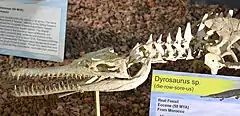Dyrosaurus
Dyrosaurus is a genus of extinct (6 metres long) crocodylomorph that lived during the early Eocene.[1] The name Dyrosaurus comes from sauros (σαῦρος) the Greek for lizard or reptile, and Dyr for Djebel Dyr (mountain close to where the type species was discovered.[2]

| Dyrosaurus | |
|---|---|
 | |
| Restored skeleton | |
| Scientific classification | |
| Kingdom: | Animalia |
| Phylum: | Chordata |
| Class: | Reptilia |
| Family: | †Dyrosauridae |
| Genus: | †Dyrosaurus Pomel, 1894 |
| Species | |
| |
Species
Although the family Dyrosauridae is quite diverse with many forms of crocodyliforms, the genus Dyrosaurus has only two described species: D. phosphaticus and D. maghribensis. D. phosphaticus was first discovered in Algeria and Tunsinia whereas D. maghribensis has only been found in Morocco.[2] D. maghribensis differs from D. phosphaticus by several synapomorphies, most notably: a smooth dorsal margin of the parietal and widely opened choanae, interfenestral bar wide and strongly T-shaped instead of moderately T-shaped. In D. maghribensis the lateral and medial dorsal osteoderms are not sutured and have no serrated margin. The anterolateral margin of medial row of the dorsal osteoderms have a rounded lateral lobe and the lateral row of dorsal osteoderms are square in shape with rounded corners. In D. phosphaticus there are four longitudinal rows of square osteoderms that are thin and have shallow and wide pits. The osteoderms are square and the anterolateral margin of the medial dorsal osteoderms have an acute rounded process directed laterally.[2]
History of discovery

French paleontologist Auguste Pomel named the genus Dyrosaurus in 1894 for Djebel Dyr, a mountain near Tebessa in Algeria where its fossilized vertebrae were found in a phosphate mine. The holotype named MNHN 1901-11 includes one tooth, one caudal vertebra,one distal extremity of an ulna and one distal extremity of a radius. There are also referred specimen, Two skulls, MNHN ALG 1 and MNHN ALG 2, and an anterior portion of a rostrum, MNHN ALG 3,from Tébessa (Algeria), material from the Faculty of Sciences of the University of Alger and deposited in the MNHN. Acomposite snout, MNHN APH 27, from Djebel Teldja, near Metlaoui, Tunisia.The first remains of Dyrosaurus were named Crocodilus phosphaticus by Thomas (1893) for Early Eocene crocodyliform remains from Gafsa, Tunisia. Pomel eventually synonymized the type species D. thevestensis with C. phosphaticus to form the new combination D. phosphaticus, making phosphaticus the epithet of the Dyrosaurus type species.[3][4][5][6] In 1903, the family Dyrosauridae was named by Giuseppe de Stefano referring to the locality for the holotype was found in Djebel Dyr, Algeria.[7]Thévenin (1911a, 1911b), with some better preserved material, recognized that Dyrosaurus phosphaticus was a Lower Eocene crocodyliform. Many dyrosaurid remains are known, but unfortunately they are often poorly preserved which makes it difficult for paleontologists to get a strong understanding of the family.[1]
References
- Jouve, S., Iarochène, M., Bouya, B., and Amaghzaz. M. 2005. A new dyrosaurid crocodyliform from the Palaeocene of Morocco and a phylogenetic analysis of Dyrosauridae. Acta Palaeontologica Polonica 50 (3): 581–594.
- Jouve, Stephane; Larochène, Mohamed; Bouya, Baâdi; Amaghzaz, Mbarek. A new species of Dyrosaurus (Crocodylomorpha, Dyrosauridae) from the early Eocene of Morocco: phylogenetic implications. 2005. Published in Zoological Journal of the Linnean Society. pg 603-656.
- Jouve, Stephanie. A new description of the skull of Dyrosaurus phosphaticus (Thomas, 1893) (Mesoeucrocodylia: Dyrosauridae) from the Lower Eocene of North Africa. 2005. Retrieved March 2, 2015 from http://cjes.nrc.ca Archived 2002-06-04 at the Wayback Machine.
- Pomel, A. 1894b. Découverte de champsosauriens dans les gisements de phosphorite du suessonien de l’Algérie. Comptes Rendude l’Académie des Sciences, 118: 1309–1310.
- Buffetaut E. 1985. L'évolution des crocodiliens. Les animaux disparus-Pour la science, Paris, p. 109
- Pomel, A. N. 1894. Découverte de Champsosauriens dans les gisements de phosphorite du suessonien de l'Algérie. Comptes Rendus de l'Académie des Sciences, 118 : 1309-1310.
- Ashu Khosla, Joseph J. W. Sertich, Guntupalli V. R. Prasad and Omkar Verma Source: Journal of Vertebrate Paleontology, Vol. 29, No. 4 (Dec. 12, 2009), pp. 1321-1326 Published by: Taylor & Francis, Ltd. on behalf of The Society of Vertebrate Paleontology Stable URL: https://www.jstor.org/stable/20627142. Accessed: 03-03-2015 07:01 UTC

